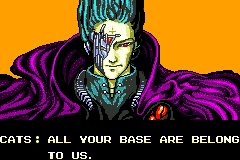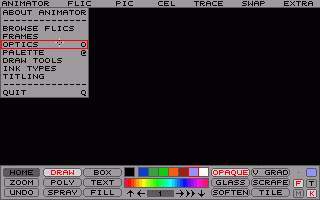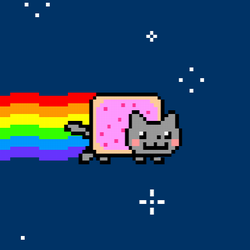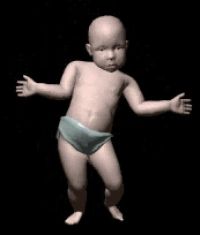
Computer animation is the process used for digitally generating moving images. The more general term computer-generated imagery (CGI) encompasses both still images and moving images, while computer animation only refers to moving images. Modern computer animation usually uses 3D computer graphics.

The Graphics Interchange Format is a bitmap image format that was developed by a team at the online services provider CompuServe led by American computer scientist Steve Wilhite and released on June 15, 1987.

"All your base are belong to us" is an Internet meme based on a poorly translated phrase from the opening cutscene of the Japanese video game Zero Wing. The phrase first appeared on the European release of the 1991 Sega Mega Drive port of the 1989 Japanese arcade game.

Autodesk Maya, commonly shortened to just Maya, is a 3D computer graphics application that runs on Windows, macOS, and Linux, originally developed by Alias and currently owned and developed by Autodesk. It is used to create assets for interactive 3D applications, animated films, TV series, and visual effects.
Autodesk, Inc. is an American multinational software corporation that provides software products and services for the architecture, engineering, construction, manufacturing, media, education, and entertainment industries. Autodesk is headquartered in San Francisco, California, and has offices worldwide. Its U.S. offices are located in the states of California, Oregon, Colorado, Texas, Michigan, New Hampshire and Massachusetts. Its Canada offices are located in the provinces of Ontario, Quebec, and Alberta.
Autodesk 3ds Max, formerly 3D Studio and 3D Studio Max, is a professional 3D computer graphics program for making 3D animations, models, games and images. It is developed and produced by Autodesk Media and Entertainment. It has modeling capabilities and a flexible plugin architecture and must be used on the Microsoft Windows platform. It is frequently used by video game developers, many TV commercial studios, and architectural visualization studios. It is also used for movie effects and movie pre-visualization. 3ds Max features shaders, dynamic simulation, particle systems, radiosity, normal map creation and rendering, global illumination, a customizable user interface, and its own scripting language.
The Hampster Dance is one of the earliest Internet memes. Created in 1998 by Canadian art student Deidre LaCarte as a GeoCities page, the dance features rows of animated GIFs of hamsters and other rodents dancing in various ways to a sped-up sample from the song "Whistle-Stop", written and performed by Roger Miller for the 1973 Walt Disney Productions film Robin Hood. In 2005, CNET named the Hampster Dance the number-one Web fad.

Bryce, also often referred to colloquially as Bryce3D, is a 3D modeling, rendering and animation program specializing in fractal landscapes. The name is taken from Bryce Canyon—a rugged region with many of the same landscapes that were first simulated with the software.

Autodesk Animator is a 2D computer animation and painting program published in 1989 for MS-DOS. It was considered groundbreaking when initially released.
Autodesk Media and Entertainment is a division of Autodesk which offers animation and visual effects products, and was formed by the combination of multiple acquisitions. In 2018, the company began operating as a single operating segment and reporting unit.

Autodesk Softimage, or simply Softimage was a 3D computer graphics application, for producing 3D computer graphics, 3D modeling, and computer animation. Now owned by Autodesk and formerly titled Softimage|XSI, the software has been predominantly used in the film, video game, and advertising industries for creating computer generated characters, objects, and environments.
Navisworks is a 3D design review package for Microsoft Windows.
The FLIC file formats most known in the extension .FLI and .FLC, used to store animation files. It is similar to animated GIF. The FLIC animation format was originally developed by Autodesk for use with Autodesk Animator (FLI) and Autodesk Animator Pro (FLC). In 1993 Jim Kent had a Dr. Dobbs article with a source code listing, introducing the FLIC format to the public.
3DS is one of the file formats used by the Autodesk 3ds Max 3D modeling, animation and rendering software.
iClone is a real-time 3D animation and rendering software program. Real-time playback is enabled by using a 3D videogame engine for instant on-screen rendering.

Nyan Cat is a YouTube video uploaded in April 2011, which became an internet meme. The video merged a Japanese pop song with an animated cartoon cat with a Pop-Tart for a torso flying through space and leaving a rainbow trail behind. The video ranked at number five on the list of most viewed YouTube videos in 2011.

Art of Illusion is a free software, and open source software package for making 3D graphics.

Verge3D is a real-time renderer and a toolkit used for creating interactive 3D experiences running on websites.







